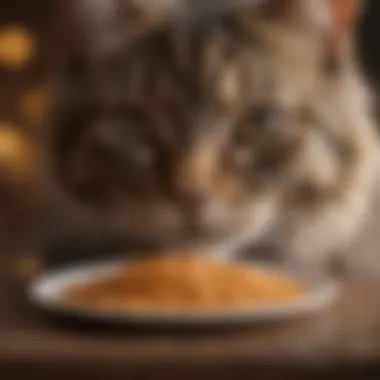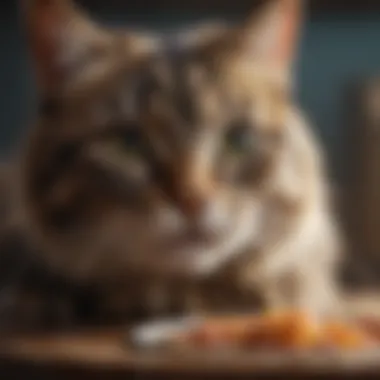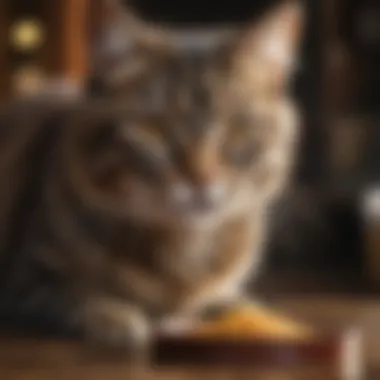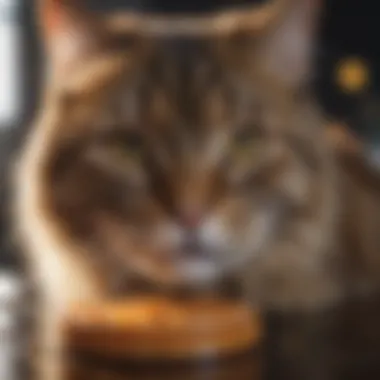Understanding Quality in Wet Cat Food for Your Pet


Intro
Wet cat food is often a focal point for discussions among pet owners worried about the health of their furry companions. Cats are obligate carnivores, meaning their diet primarily consists of meat. Wet food typically offers high moisture content, which is beneficial for hydration, and can assist in maintaining overall kidney health.
In this article, we will dissect what defines quality in wet cat food. We'll delve into critical nutritional components, the importance of ingredient sourcing, and the role that quality assurance plays in manufacturing. Plus, we will review well-known brands that stand out in the market and assess dietary preferences tailored to various types of cats. By the end of this exploration, pet owners will have an informed toolkit to navigate the multitude of products available, ensuring their choices meet the specific needs of their feline friends.
Preamble to Wet Cat Food
When it comes to feeding our feline friends, choosing the right food is crucial. Wet cat food, specifically, plays a significant role in a cat's diet. It's not just about filling their bellies; it's about ensuring they're getting all the nutrients they need to thrive. As we navigate through this article, we'll uncover the ins and outs of wet cat food and why understanding its quality matters.
First off, let’s define what wet cat food actually is. This type of food is primarily made up of higher moisture content compared to dry kibble, usually consisting of meat or fish, and it often comes in cans or pouches. The increased moisture not only makes it more palatable but also contributes to the overall hydration of your pet.
One of the key benefits of wet cat food is its appeal to the pickiest eaters. Cats, like humans, have their preferences, and the texture and flavor of wet food can entice even the most finicky diners. Moreover, this kind of food can be an effective tool for kittens who are just transitioning from nursing to solid food, as it provides essential hydration and easy chewability.
Additionally, wet cat food has been shown to have a positive impact on a cat’s hydration levels. Many cats do not drink enough water; thus, wet food can help meet their hydration needs conveniently. The increased moisture also proves advantageous for cats prone to urinary problems as it aids in preventing issues like urinary tract infections.
In short, as we dive deeper into the specifics of wet cat food—including its nutritional profiles, ingredient analysis, and the popular brands on the market—we'll equip pet owners with essential tools to select high-quality options that their pets will love.
Key Attributes of Quality Wet Cat Food
When it comes to choosing wet cat food, understanding the key attributes that signify quality is crucial. Pet owners ought to sift through the myriad of options available, and focusing on specific elements plays a huge role in ensuring that your feline friend receives a nourishing and satisfying diet. Quality cat food should not only meet basic nutritional guidelines but also treasure high-quality ingredients and transparent sourcing practices. Each of these aspects contributes positively to your cat's well-being and can significantly impact their overall health.
Nutritional Adequacy
Essential Nutrients
Nutritional adequacy revolves around the idea that wet cat food must deliver all the essential nutrients that a cat needs to thrive. Unlike humans, cats are obligate carnivores, relying predominantly on animal-based proteins and key nutrients derived from meat. Key nutrients in wet cat food include:
- Taurine: This is an amino acid that supports heart and eye health in felines.
- Omega fatty acids: Vital for maintaining skin and coat health, these are crucial too.
- Vitamins and minerals: Essential for bone health, metabolism, and several other bodily functions.
A significant characteristic of essential nutrients is their role in maintenance of optimal health. For instance, taurine deficiency can lead to severe health issues, including heart disease. The unique feature of essential nutrients lies in their sourcing; high-quality wet food often utilizes real meat rather than synthetic alternatives, enriching the diet with the necessary building blocks of good health. When choosing cat food, selecting options rich in these nutrients can keep your feline happy and healthy in the long run.
Understanding AAFCO Standards
The Association of American Feed Control Officials (AAFCO) develops guidelines that help define the nutritional adequacy of pet food. Understanding AAFCO standards is integral as it ensures that the food meets the minimum nutritional requirements for cats. AAFCO’s nutrient profiles specify the essential nutrients that formulations should contain.
The benefit of adhering to these standards is that pet owners can rest assured they are selecting a product that meets industry benchmarks for quality. A unique aspect of AAFCO standards is that they require companies to conduct feeding trials to validate their claims about nutrient adequacy. However, not all brands follow these standards, which means not every can or pouch will guarantee the same level of quality. Therefore, it is crucial for cat owners to look for labeling that meets AAFCO guidelines.
Ingredient Quality
Whole vs. By-products
Ingredient quality can make or break the overall effectiveness of wet cat food. When discussing whole ingredients versus by-products, it becomes clear how the composition can influence your cat's health. Whole ingredients, such as real chicken or beef, contain valuable protein and nutrients necessary for optimal cat health. Conversely, by-products typically refer to lesser quality parts of the animal, which may include organs and bones that are less desirable.
The key characteristic of whole ingredients is that they are more nutrient-dense and offer a cleaner food source. However, it cannot be ignored that some high-quality by-products (like organ meats) can also provide essential nutrients. Thus, understanding the difference and its implications allows pet owners to make informed choices rather than opting blindly for marketing promotions.
Sourcing Transparency
Sourcing transparency sheds light on where ingredients come from, maintaining the integrity of the food you choose for your cat. This concept has gained momentum in recent years; many consumers demand to know the origins of their pet food ingredients. Brands that offer sourcing transparency do so by openly sharing information about their suppliers and the journey of their ingredients.
The primary advantage of sourcing transparency is that it builds trust between the consumer and the manufacturer. You can better evaluate the quality of ingredients in the food you choose, ensuring it meets your high standards. On the downside, some brands may offer overwhelming or confusing information that might not be easily interpretable for the average consumer. Therefore, it’s best to seek out brands that provide clear, digestible information regarding ingredient sourcing.
Transparency in sourcing not only improves trust but also connects pet owners to the origin of their pets’ diets, enabling safer and more mindful feeding practices.
In summary, understanding these key attributes, from nutritional adequacy to ingredient quality, is instrumental in making informed decisions about the wet cat food you provide for your furry companions. Prioritizing these factors will undoubtedly help ensure a healthy and happy feline.
Ingredient Analysis
Ingredient analysis plays a critical role in determining the quality of wet cat food. For responsible pet owners, understanding the ingredients in their furry companions’ diet isn’t just a matter of curiosity; it’s a necessity for ensuring their cats receive balanced and healthful nutrition.
When diving into the world of wet cat food ingredients, it's important to consider not just what is present but also the quality of those ingredients. A thorough ingredient analysis sheds light on the nutrients that constitute the food, offering insight into how well it meets the specific dietary needs of different cats.
Proteins


Animal-based Proteins
Animal-based proteins are the cornerstones of a cat's diet. This type of protein originates from meat, fish, or poultry and is highly digestible, making it an excellent source of essential amino acids which are crucial for your cat’s vitality.
A significant characteristic of animal-based proteins is their rich profile of amino acids. Cats are obligate carnivores, meaning they thrive on nutrients found primarily in animal tissues. This makes animal-based proteins a beneficial choice, as they closely mimic what a cat would consume in its natural habitat. Unique features include their potential to support muscle health, provide energy, and contribute to a robust immune system. However, it's crucial to source these proteins from reputable manufacturers to avoid the pitfalls of low-quality by-products that may be less digestible.
Vegetable Proteins
On the other side of the coin, we have vegetable proteins. Sourced from plants, these proteins can contribute to the protein content of wet cat foods, albeit with some notable differences compared to their animal counterparts. While not as nutritionally complete as animal proteins, vegetable proteins offer an alternative that some brands use to reduce costs.
These proteins can be beneficial, particularly in formulations aimed at cats with specific sensitivities. They often come with fiber, which aids in digestion and can help control hairballs. The downside, however, is that not all vegetable proteins provide complete amino acid profiles, meaning they should supplement rather than replace high-quality animal proteins in cat diets.
Carbohydrates
Complex Carbs
Complex carbohydrates are another ingredient that warrants attention. Unlike simple carbohydrates, which can spike a cat's blood sugar, complex carbs release energy gradually. This property makes them a solid choice for maintaining steady energy levels for both active adolescent cats and calmer adult cats.
The unique feature of complex carbs lies in their fiber content, which promotes gut health and can assist with weight management. However, while some carbs can play a supportive role, excessive carbs can lead to health issues such as obesity. Thus, it’s essential that they make up only a small fraction of the overall ingredient list.
Avoiding Fillers
A vital aspect of ingredient analysis is the emphasis on avoiding fillers in wet cat food. Fillers are often low-quality ingredients that provide minimal nutritional value while contributing to the food's bulk. Common fillers include corn, wheat, and soy, which serve no beneficial purpose in a cat’s diet.
Identifying food that avoids fillers is crucial for ensuring that cats receive optimal nutrition rather than unnecessary calories. By steering clear of filler-rich products, pet owners can provide their feline friends with more wholesome ingredients, ultimately leading to better health outcomes and improved well-being.
Fats
Essential Fatty Acids
Fats are often misunderstood, but they are indispensable in a cat's diet. Essential fatty acids, such as Omega-3 and Omega-6, play pivotal roles in various body functions. They support skin and coat health, assist in reducing inflammation, and bolster brain development.
What makes essential fatty acids so beneficial is their ability to provide energy while also being crucial for cellular structure and function. Their unique feature is that these fatty acids cannot be produced by the body and must therefore come from the diet, underscoring the importance of including them in wet cat food formulations.
Sources of Fats
Finally, the sources of fats in wet cat food matter greatly. Good-quality fats come from animal protein sources, such as fish oil or poultry fat, which add not only caloric content but also essential nutrients conducive to overall health.
When sourcing fats for cats, it’s essential to look for descriptions that indicate high-quality origins. This practice helps ensure healthy fatty acid ratios. However, it is worth noting that while some sources can be beneficial, others lead to unhealthy weight gain or digestive issues if consumed in excess. Therefore, choosing a wet cat food with balanced fat content remains paramount in assessing its quality.
Understanding these ingredients—proteins, carbohydrates, and fats— allows pet owners to make informed decisions and better cater to their cats' unique dietary needs.
Popular Brands of Wet Cat Food
When it comes to selecting wet cat food, the brands you choose play a significant role in providing quality nutrition for your feline companion. This section isn’t just about naming brands but also diving into what they represent in terms of quality, nutrition, and even affordability. For pet owners, weighing the pros and cons of popular options is essential, as the right food can influence your cat’s excitement at mealtime and overall wellbeing.
Premium Brands
Brand A Overview
Brand A is often touted for its focus on high-quality ingredients. What sets it apart is its commitment to using only animal-based proteins sourced from reputable farms. This characteristic positions Brand A as a beneficial option for those who prioritize meat as a primary ingredient in their cat’s diet.
Its unique feature lies in the absence of fillers, which has made it a popular choice among holistic pet food enthusiasts. Pet owners frequently report noticeable increases in their cat’s energy and coat health when feeding this brand. However, one must consider its price point—though higher, many believe the investment is worth the benefits received.
Brand B Overview
Brand B presents a slightly different approach, specializing in a variety of flavors and textures, appealing to even the pickiest eaters. This brand shines for its commitment to transparency, providing clear information about ingredients and sourcing on its website. The most attractive aspect is its affordability compared to other premium brands, making it accessible for a wider audience without compromising on quality.
The unique feature that distinguishes Brand B is its strategic use of whole grains and vegetables, contributing to balanced nutrition and fiber inclusion. However, while many cats enjoy the flavours, some owners have found that individual cats may prefer more meat-centric options.
Affordable Options
Brand Overview


Brand C caters to budget-conscious pet owners without skimping on nutritional value. This brand has gained traction for its ability to deliver tasty wet food at a lower price point. One key characteristic is its focus on whole ingredients, often emphasizing meat as the first ingredient—something that resonates with many cat owners.
What makes Brand C particularly appealing is its wide distribution. It can be found in numerous retail stores, making it accessible for regular purchases. However, some discerning pet owners have pointed out potential concerns regarding the use of by-products, depending on the specific formulations.
Brand Overview
Brand D represents another affordable option worth mentioning. It balances cost and quality effectively, drawing attention for its commitment to using natural ingredients and avoiding artificial additives. This brand often tailors specific formulas for different life stages, ensuring that both kittens and adult cats find appropriate meals tailored to their needs.
The hallmark of Brand D is its focus on sustainability; they often highlight eco-friendly sourcing practices on their packaging. However, while many cats thrive on this food, a few owners have reported that ingredients may vary by batch, raising some concerns about consistency.
Evaluating Quality Assurance in Pet Food Production
Assessing quality assurance in pet food production is essential for many reasons. When choosing wet cat food, pet owners want to ensure their chosen products meet high standards of safety and nutrition. This evaluation involves scrutinizing not just the ingredients but also the process behind their creation. Understanding products' manufacturing standards and labeling transparency is crucial in making informed decisions about feline diets.
Manufacturing Standards
FDA Regulations
The FDA is the backbone of food safety in the United States. Their regulations concerning pet food are designed to protect pets from harmful substances. A critical aspect of FDA regulations is ensuring that all ingredients used in wet cat food are safe and suitable for consumption. This includes guidelines on what can be included, how it should be processed, and where it must be sourced from.
Key characteristics of these regulations include stringent testing protocols and mandatory labeling that must reflect the real contents of the food. These rules help establish a standard for what pet owners should expect from wet cat food. The benefits of adhering to FDA guidelines can't be overstated; they set the stage for confidence in a product's safety and nutritional adequacy.
Moreover, FDA regulations uniquely facilitate traceability, allowing manufacturers and consumers to track the origins of ingredients. This transparency can be advantageous in identifying potential allergens or trouble spots for specific cats. However, navigating the world of pet food labeling and regulations isn’t without its challenges, as some brands might stretch these rules to maximize profits, which can lead to confusion.
Quality Testing Procedures
Quality testing procedures are another important part of ensuring the safety and efficacy of wet cat food. These involve various checks and assessments conducted at different stages of production to identify any potential issues, like contamination or nutrient deficiencies. A vital characteristic of quality testing is its role in ongoing monitoring post-production; this isn't a one-stop shop but a continuous process.
Quality tests often include microbiological assays, nutrient profiling, and shelf-life evaluations. The consistent application of these tests is viewed favorably because it helps ensure that every batch of cat food meets the expected standards. The unique feature of these procedures is their flexibility—manufacturers can adapt testing according to specific health concerns identified in their brands.
Nevertheless, it's important to be cautious. Some companies might cut corners, performing limited testing to save time or expense. This can lead to the release of subpar products into the market, putting pets at risk.
Labeling Transparency
Understanding Labels
Understanding labels is key in evaluating the quality of wet cat food. Labels provide vital information like nutritional profiles, ingredient lists, and feeding guidelines. Knowing how to read and interpret these labels can be the difference between selecting a healthy option and a subpar one. A key characteristic of good labeling is clarity; manufacturers should present information concisely without hype or misleading statements.
A major benefit of label transparency is that it empowers pet owners to choose based on real data tailored to their pets' needs. Shoppers can evaluate aspects like protein content, moisture levels, and the presence of fillers. However, labels that are overly technical or loaded with industry jargon can be daunting. This complexity might lead consumers to misinterpret information, unwittingly selecting items that don’t truly cater to their cats' unique dietary requirements.
Interpreting Ingredients List
Interpreting the ingredients list is another critical element in evaluating wet cat food quality. The list not only tells us what goes into the food but also reveals the quality of those ingredients. One characterizing factor of a good ingredients list is it should start with high-quality protein sources, followed by whole foods, not fillers.
Common pet food ingredients often include deboned chicken, fish meal, or even vegetables, demonstrating a balanced approach to nutrition. Understanding this list helps buyers avoid products with ambiguous terms such as "meat by-products," which can raise safety concerns. Thus, effective ingredient lists serve as effective tools for discerning the quality of wet cat food. While a well-rounded list supports overall health, ingredients that don't mesh with the needs of your cat could lead to dietary complications.
Finale
In summary, evaluating quality assurance in pet food production begins with understanding the manufacturing standards and rules, particularly those set by the FDA. Likewise, thorough quality testing and clear labeling offer significant advantages, enabling informed decision-making. By carefully scrutinizing both the regulations and the labels, pet owners can better navigate the somewhat overwhelming world of wet cat food, thereby making healthier choices for their feline companions.
Dietary Needs and Preferences
Understanding the dietary needs and preferences of cats is critical when discussing the quality of wet cat food. Cats are obligate carnivores, which means their diets must primarily consist of meat to thrive. This fundamental aspect shapes the specific requirements that vary across different life stages, as well as for those with unique health conditions.
Kittens vs. Adult Cats
Nutritional Requirements for Kittens
Kittens have unique nutritional requirements compared to their adult counterparts. They need higher protein levels to support their rapid growth and development. When kittens are nursing or starting on wet food, their food should contain at least 30% protein content, as it plays a vital role in building muscle and energy.
What makes kitten food a popular choice among pet owners is its carefully balanced ratio of fat, protein, and key vitamins. These nutrients are specifically tailored to support young feline health. For instance, Taurine is an amino acid crucial for brain development. Its unique feature in kitten formulas can often lead to noticeable differences in growth and energy levels in these young pets.
The advantages of selecting high-quality wet food for kittens are plenty. It allows for easy chewing and digestion, facilitating nutrient absorption during this critical developmental phase. However, it's essential to be cautious about providing adult cat food to kittens, as it lacks the necessary nutrients essential for their development.


Adjusting for Adult Cats
As cats transition into adulthood, their dietary needs morph to a lesser extent. Adult cats typically require a diet with around 25% protein. This reduction stems from their slower metabolism and lower activity levels, compared to those demanding youthful kittens.
The key characteristic of adult cat food is that it tends to focus on maintaining healthy weight while still delivering sufficient energy. The ingredient content shifts slightly towards a more balanced mix of fats, fibers, and proteins, supporting an overall healthy cat.
One unique aspect of adult cat food is the inclusion of joint-supporting nutrients, like glucosamine, often not found in kitten formulas. This feature is especially beneficial for indoor cats, who might be more prone to weight gain and joint issues. However, one must be wary of overweight cats, which can lead to serious health issues. So, while it's a great idea to have specialized categories, understanding each cat's condition is essential as excess weight can become a disadvantage.
Cats with Special Dietary Needs
Allergies and Food Sensitivities
Allergies and food sensitivities in cats can lead to a host of problems if not handled properly. When selecting wet cat food, it's critical to steer clear of common allergens, such as dairy or grains, which might trigger reactions. Think of your cat like a fussing toddler about certain foods they might not agree with.
The key characteristic of food tailored for feline allergies is the incorporation of limited ingredients. This approach helps identify potential allergens easily. In this segment of the pet food market, options like limited-ingredient diets or hypoallergenic formulas are not only popular but often necessary for cats with sensitive stomachs. One unique feature to look for is novel protein sources, such as duck or kangaroo, which most cats have not been exposed to, reducing the chance of allergic reactions.
Having these tailored food options can provide substantial relief and improve overall well being for our furry friends. While beneficial, finding the right brand with transparency about sourcing ingredients might often take some effort.
Health Conditions Impacting Diet
Many cats live with health conditions that fundamentally affect their diets. Chronic diseases like kidney disease, diabetes, or urinary tract issues compel them to have modified nutritional plans. It’s akin to putting together a jigsaw puzzle; every piece matters.
The unique characteristic of diets for such special needs is their emphasis on low phosphorus and high-quality protein sources. For instance, cats with kidney problems typically benefit from wet food offerings lower in phosphorus. Wet food helps with hydration — particularly relevant for cats that are prone to urinary problems.
Consequently, understanding what each condition entails opens possibilities for discovering effective dietary solutions. Owners can often work closely with veterinarians to determine which foods align best with these conditions, thereby enhancing their furry friends' quality of life.
Choosing the right wet cat food isn't merely about following trends; it's about acknowledging what each cat needs to be healthy, engaged, and vibrant. With the right knowledge, pet owners can navigate this complex landscape, ensuring every cat receives the nutrition they require.
The Role of Wet Cat Food in Feline Health
In exploring the choices we make for our feline companions, the role of wet cat food often surfaces as a critical aspect of their overall health. This section emphasizes how not just the nutritional content, but also the unique properties of wet food can significantly contribute to a cat's well-being. A wise cat owner understands that food is more than just a meal; it is an integral part of maintaining the health, vitality, and happiness of their beloved pets.
Impact on Hydration
Cats have a notorious reputation for being rather selective drinkers. Their ancestors, primarily desert dwellers, evolved a physiological composition that allows them to thrive on minimal water intake. However, this ancestral trait has led to complications in domesticated felines, making hydration a hefty concern.
Wet cat food, rich in moisture content, generally comprises between 70% to 80% water, a significant boon for pet owners looking to ensure their cats remain well-hydrated. By incorporating wet food into their diets, you can help mitigate the risk of urinary tract issues and kidney problems that arise from dehydration.
- Water Content: Cats often mistake dry food for mere crunchies, neglecting adequate water intake. In contrast, wet food not only provides hydration but also offers a palatable option for them to consume.
- Prevention of Health Issues: Optimal hydration directly impacts kidney function. Cats that consume a diet inclusive of wet food are less likely to suffer from chronic dehydration, thus protecting their kidneys as well as lowering the risks associated with urinary crystals.
Consider incorporating wet food into your cat's diet gradually. Mixing it with dry food to start might snag their interest, ensuring they maintain a sufficient fluid intake throughout the day. This adjustment to their meal plan can create lasting benefits for their hydration.
Dental Health Considerations
Cats, unlike humans, do not have access to regular dental care routines. Therefore, their oral health is often taken for granted. Many believe that dry food serves as a natural toothbrush, scraping plaque away as cats chew, but recent studies suggest that this is not universally effective. Wet cat food can serve another dimension in a cat's dietary needs, particularly concerning their dental health.
- Soft Texture Benefits: The softer consistency of wet food can cause less wear on a cat's teeth and gums when compared to dry food. Cats with sensitive gums or those who are older often benefit from the ease of consumption that wet food provides.
- Reducing Plaque and Tartar Build-up: It's not to say that wet food is a substitute for dental miracles, but it does have a role in the mix. Some brands offer specific wet food products with additives aimed at combatting plaque and tartar build-up, which can improve overall dental hygiene over time.
Research has shown that a well-balanced diet, particularly one that includes wet food, can help maintain dental health in cats and reduce the cost and frequency of dental treatments.
End
Navigating the often murky waters of pet nutrition can feel like trying to find a needle in a haystack. As a conscientious cat owner or anyone involved in feline health, understanding the ins and outs of wet cat food is of paramount importance. This article has laid the groundwork, outlining what truly constitutes quality in wet cat food. It’s not just about picking up a can off the supermarket shelf; it’s an exercise in discernment that can significantly affect your cat's well-being.
Making Informed Choices
In making informed choices, a few critical elements come into play:
- Nutritional Adequacy: Understand how to evaluate if the food meets essential nutrient requirements to support your cat's health.
- Ingredient Transparency: Familiarity with the difference between whole ingredients versus by-products can guide you towards better quality options.
- Brand Reputation: Not all brands are created equal; it’s wise to consider a brand’s history and quality control processes.
Benefits of Being Informed
Being equipped with reliable knowledge lets you sidestep the pitfalls of misleading marketing and expired trends. Here are some notable benefits of being the informed consumer:
- Health Outcomes: An educated choice can lead to better health, improved coat quality, and heightened energy in your feline.
- Cost-Effectiveness: Investing in high-quality food may seem costly upfront but can mitigate health issues down the line, helping dodge expensive veterinarian bills.
- Peace of Mind: Knowing that you’re providing the best possible nutrition to your pet alleviates the anxiety that often accompanies pet ownership.
The simple act of reading labels and understanding ingredient lists can empower you to make choices that favor health over convenience.
As you wrap your head around the myriad choices available in the world of wet cat food, take your time to evaluate, question, and decide. Your cat’s dietary needs deserve your full attention; after all, they rely on you to make choices that will impact their health and happiness.
This comprehensive guide is just the beginning. The journey toward understanding quality wet cat food can open doors to living healthier lives for our feline friends, merging knowledge with decisive action for their betterment.







